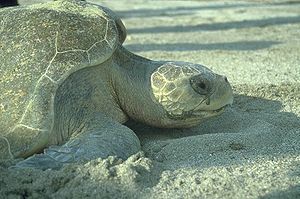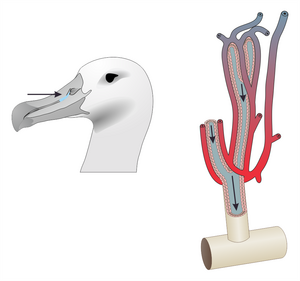Salt gland

The salt gland is an
Salt glands maintain
In birds


The avian salt gland has two main ducts: a medial and a lateral. Salt gland activations occurs from increased osmolarity in the blood, stimulating the hypothalamic information processing, sending a signal through the
The supraorbital gland is a type of lateral nasal gland found in some species of marine birds, particularly penguins, which removes sodium chloride from the bloodstream. The gland's function is similar to that of the kidneys, though it is much more efficient at removing salt, allowing penguins to survive without access to fresh water. The supraorbital gland is also possessed by the European herring gull - allowing the seagull to drink seawater without becoming ill, although it prefers to drink fresh water when available.[4] Contrary to popular belief, the gland does not directly convert saltwater to freshwater. The term supraorbital refers to the area just above the eye socket (which is known as the orbit).
Living in saltwater environments would naturally pose a large problem for penguins because the ingestion of
The penguin excretes the salt byproduct as a brine through its bill. Often, the fluid drips out, and this gives the appearance of a runny nose. However, the fluid may also be sneezed out. In the absence of saltwater, caused by captivity, the supraorbital gland will lie dormant as it has no other purpose. Having a dormant supraorbital gland does not negatively affect the health of a penguin.
In reptiles
The need for salt excretion in reptiles (such as marine iguanas and sea turtles) and birds (such as petrels and albatrosses) reflects their having much less efficient kidneys than mammals.[5] Unlike the skin of amphibians, that of reptiles and birds is impermeable to salt, preventing its release.[6]
The evolution of a salt gland in early reptiles and birds allowed them to eat aquatic plants and animals with high salt concentrations. This evolutionary development does not account for the gland in
Some theories suggest
See also
References
- S2CID 28638773.
- ^ O’Driscoll, K.J.; Staniels, L.K.; Facey, D.E. "Osmoregulation and Excretion". Archived from the original on 8 July 2007. Retrieved 6 July 2007.
- PMID 16351835.
- ^ Dewey, Tanya; Spencer, Shane. "ADW: Larus argentatus: INFORMATION". Animal Diversity Web. Retrieved 8 April 2023.
- ^ "Plants Poisonous to Livestock - Cornell University Department of Animal Science". Ansci.cornell.edu. Retrieved 14 July 2011.
- ISBN 978-0-520-23854-1.
Further reading
- Evans, D. H. 1993. Osmotic and Ionic Regulation. pp. 315–336. In Evans, D. H. 1993. The Physiology of Fishes. CRC Press, Boca Raton, Florida.
- Goldstein, D. L. 2002. Water and Salt Balance in Seabirds. pp. 467–480. In Schreiber, E. A. and J. Burger. (eds.) 2002. Biology of Marine Birds. CRC Press, Boca Raton, Florida.
- Schmidt-Nielsen, K. 1959. Salt Glands. pp. 221–226. In Wessells, N. K. (comp.) 1974. Vertebrate Structures and Functions. W. H. Freeman and Company, San Francisco, CA.
- Wǖrsig, B. G., T. A. Jefferson and D. J. Schmidly. 2000. The Marine Mammals of the Gulf of Mexico. Texas A&M Press, College Station, TX.
External links
- "nasal gland". Encyclopædia Britannica. 2010.
- Cummins, Jim (1 April 1996). "Urogenital and Endocrine Systems". Archived from the original on 18 September 2006.

